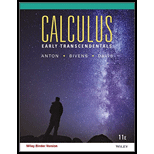
Let C be the curve
(a) Find the area of the surface generated by revolving
(b) Find the area of the surface generated by revolving
(c) Find the area of the surface generated by revolving
Want to see the full answer?
Check out a sample textbook solution
Chapter 6 Solutions
Calculus Early Transcendentals, Binder Ready Version
Additional Math Textbook Solutions
Basic Business Statistics, Student Value Edition
Elementary Statistics
A First Course in Probability (10th Edition)
Thinking Mathematically (6th Edition)
- Write an equation for the polynomial graphed below 6+ 5 + -5 -4 3 y(x) = 4 3 2 1 -1 1 1 -1 -2 -3 -4 -5 2 3 4 5arrow_forwardWrite an equation for the polynomial graphed below 5+ 4 3 1 + + + -5-4-3-2 1 13 4 5 -1 -2 -3 -4 -5+ 4 5 Q y(x) =arrow_forward3. Solve the inequality, and give your answer in interval notation. - (x − 4)³ (x + 1) ≥ 0arrow_forward
- 1. Find the formula to the polynomial at right. Show all your work. (4 points) 1- 2 3 сл 5 6 -4 -3 -2 -1 0 2 3arrow_forward2. Find the leading term (2 points): f(x) = −3x(2x − 1)²(x+3)³ -arrow_forward1- √ √ √³ e³/√xdy dx 1 cy² 2- √ √² 3 y³ exy dx dy So 3- √ √sinx y dy dx 4- Jo √² Sy² dx dyarrow_forward
- A building that is 205 feet tall casts a shadow of various lengths æ as the day goes by. An angle of elevation is formed by lines from the top and bottom of the building to the tip of the shadow, as de seen in the following figure. Find the rate of change of the angle of elevation when x 278 feet. dx Round to 3 decimal places. Γ X radians per footarrow_forwardUse the information in the following table to find h' (a) at the given value for a. x|f(x) g(x) f'(x) g(x) 0 0 0 4 3 1 4 4 3 0 2 7 1 2 7 3 3 1 2 9 4 0 4 5 7 h(x) = f(g(x)); a = 0 h' (0) =arrow_forwardUse the information in the following table to find h' (a) at the given value for a. x f(x) g(x) f'(x) g'(x) 0 0 3 2 1 1 0 0 2 0 2 43 22 4 3 3 2 3 1 1 4 1 2 0 4 2 h(x) = (1/(2) ²; 9(x) h' (3)= = ; a=3arrow_forward
- The position of a moving hockey puck after t seconds is s(t) = tan a. Find the velocity of the hockey puck at any time t. v(t) ===== b. Find the acceleration of the puck at any time t. -1 a (t) = (t) where s is in meters. c. Evaluate v(t) and a (t) for t = 1, 4, and 5 seconds. Round to 4 decimal places, if necessary. v (1) v (4) v (5) a (1) = = = = a (4) = a (5) = d. What conclusion can be drawn from the results in the previous part? ○ The hockey puck is decelerating/slowing down at 1, 4, and 5 seconds ○ The hockey puck has a constant velocity/speed at 1, 4, and 5 seconds ○ The hockey puck is accelerating/speeding up at 1, 4, and 5 secondsarrow_forwardquestion 8arrow_forwardFind the area of the surface obtained by rotating the circle x² + y² = r² about the line y = r.arrow_forward
 Trigonometry (MindTap Course List)TrigonometryISBN:9781337278461Author:Ron LarsonPublisher:Cengage Learning
Trigonometry (MindTap Course List)TrigonometryISBN:9781337278461Author:Ron LarsonPublisher:Cengage Learning
